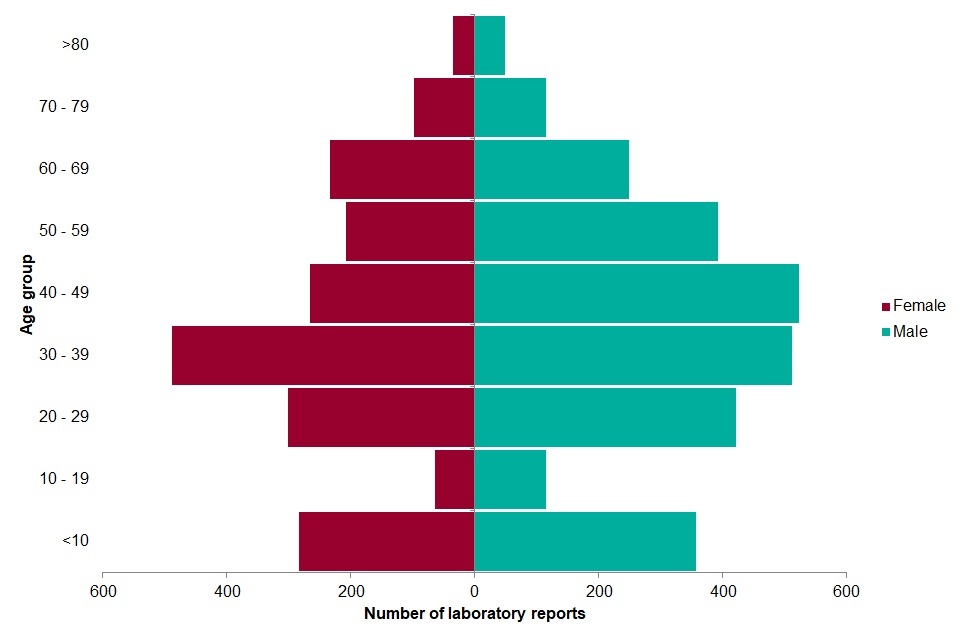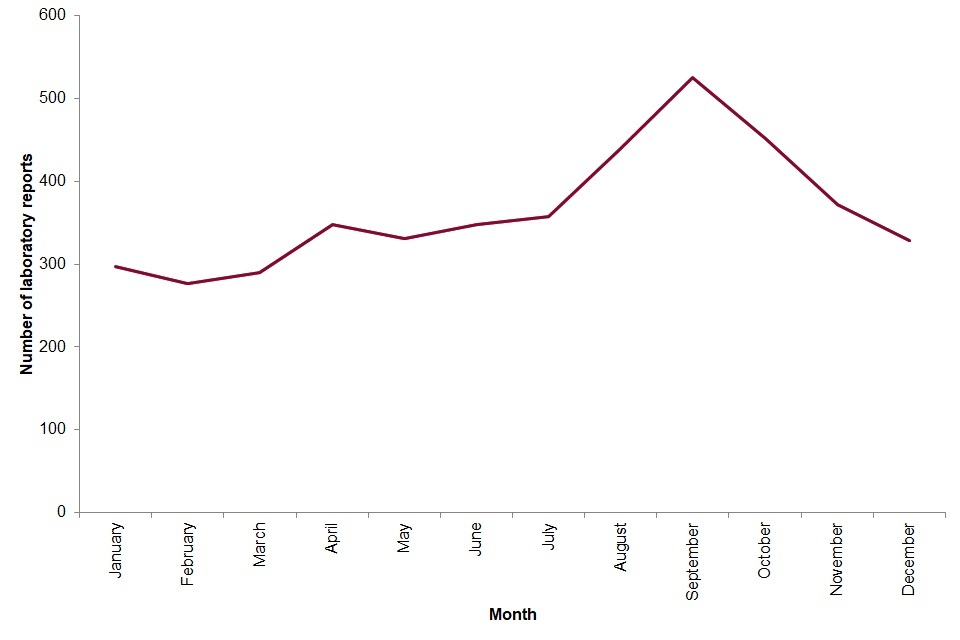Giardia data 2007 to 2016
Published 30 May 2019
1. Main points for 2016
The number of Giardia reports has increased year on year since 2013. This increase is largely attributable to the introduction of molecular or antigen based diagnostic methods by front line diagnostic laboratories.
The region with the highest number of Giardia laboratory reports was the South West of England with 996 laboratory reports.
The South West of England also had the highest rate of Giardia laboratory reports per 100,000 population in England and Wales with 18.1 laboratory reports per 100,000 population.
Reporting numbers were highest for males aged 40 to 49 in 2016.
In 2016, the peak month for Giardia reporting was September.
There were no foodborne or non-foodborne outbreaks of Giardia reported in England and Wales during 2016.
2. Giardia data, 2007 to 2016
All data presented in this report are correct as of 3 November 2017.
2.1 Annual data: 2007 to 2016
Table 1: annual laboratory reports of Giardia in England and Wales 2007 to 2016[footnote 1]
| Year | Number of laboratory reports | per 100,000 population |
|---|---|---|
| 2007 | 3,054 | 5.6 |
| 2008 | 3,342 | 6.1 |
| 2009 | 3,501 | 6.3 |
| 2010 | 3,858 | 6.9 |
| 2011 | 3,697 | 6.6 |
| 2012 | 3,902 | 6.9 |
| 2013 | 3,622 | 6.4 |
| 2014 | 4,039 | 7 |
| 2015 | 4,390 | 7.6 |
| 2016 | 4,492 | 7.7 |
Figure 1: annual laboratory reports of Giardia in England and Wales (2007 to 2016)

A bar graph showing the number of laboratory reports each year.
2.2 Regional data: 2016
Table 2: regional distribution[footnote 2] of laboratory reports of Giardia in England and Wales 2016
| Country | Region | Laboratory reports | per 100,000 population |
|---|---|---|---|
| England | East Midlands | 372 | 7.9 |
| England | East of England | 309 | 5.0 |
| England | London | 445 | 5.1 |
| England | North East | 188 | 7.1 |
| England | North West | 524 | 7.3 |
| England | South East | 766 | 8.5 |
| England | South West | 996 | 18.1 |
| England | Yorkshire and The Humber | 299 | 5.5 |
| England | West Midlands | 345 | 5.9 |
| Wales | Wales | 128 | 4.1 |
2.3 Age and sex distribution: 2016
Figure 2: age and sex distribution of laboratory reports of Giardia reported in England 2016[footnote 3].

A bar graph showing the number of laboratory reports in 2016 by age and sex.
2.4 Seasonal variation: 2016
Figure 3: seasonality of laboratory reports of Giardia reported in England 2016[footnote 4].

A line graph showing the seasonal trend of Giardia infections in 2016.
2.5 Outbreak data: 2016
In 2016, there were no foodborne or non-foodborne outbreaks of Giardia reported in England and Wales.
3. Data sources
Data sources include:
- Public Health England Second Generation Surveillance System (SGSS). This is a live laboratory reporting system therefore numbers may fluctuate. Data provided in this report are new extractions from this system and provide updated figures to previously published reports. In 2014, PHE upgraded the laboratory reporting system so direct comparisons between data reported from the previous system (LabBase2) and the new system (SGSS) may require cautious interpretation.
4. Acknowledgements
We are grateful to:
- the microbiologists, local authorities and local health protection and environmental health specialists who have contributed data and reports to national surveillance systems
- the epidemiologists and information officers who have worked on the national surveillance of gastrointestinal (GI) infectious diseases
- colleagues in the Gastrointestinal Bacterial Reference Unit (GBRU) for providing the Reference Laboratory Services and laboratory surveillance functions and expertise
- the PHE Information Management Department for maintenance and quality assurance of PHE national surveillance databases for GI diseases
- PHE Local Public Health Laboratories and Food Water and Environmental Microbiology Services for providing a surveillance function for GI pathogens and testing of food and environmental samples routinely and during outbreak investigation
- PHE National Parasitology Reference Laboratory, Department of Clinical Parasitology, University College London Hospital NHS Foundation Trust for their expertise
- all colleagues who have investigated and reported outbreaks to the Electronic Foodborne and Non-Foodborne Gastrointestinal Outbreak Surveillance System (eFOSS)
PHE has a statutory obligation to collect and report outbreaks of foodborne disease. This is aligned to the requirements of the Zoonoses Directive 2003/99/EC. This directive requires that EU member states investigate and report all foodborne outbreaks to the European Food Safety Authority (EFSA).
-
Incidence rates were calculated using the relevant Office for National Statistics (ONS) mid-year population estimates for each year. ↩
-
Regional classification based on place of residence of laboratory reports and classified using Nomenclature of Territorial Units for Statistics 1 (NUTS 1) codes. Incidence rates were calculated using the Office for National Statistics (ONS) mid-year population estimates for each region. ↩
-
For laboratory reports where age and sex data were available. Data not available for all Welsh laboratory reports and, therefore, not included. There were 12 laboratory reports with unknown data recorded. ↩
-
Excludes Welsh data. ↩
